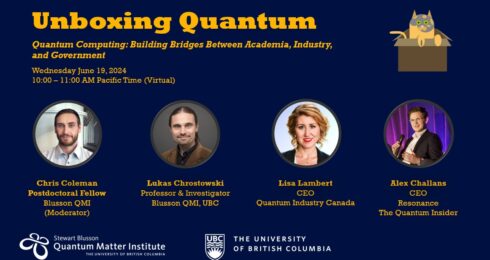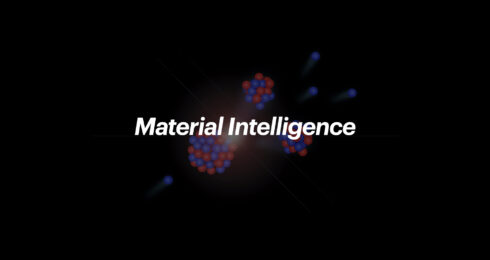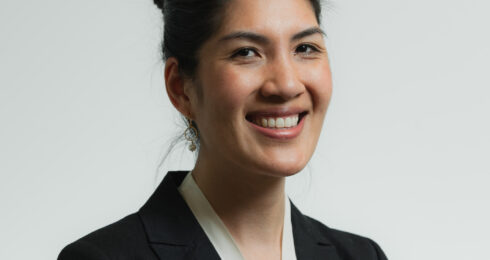Hosted by the Stewart Blusson Quantum Matter Institute (Blusson QMI), the Helen and Morris Belkin Gallery (the Belkin) and UBC’s Department of Physics and Astronomy, Ars Scientia’s second annual symposium: encou(n)ters, took place in UBC Botanic Gardens Reception Centre on May 15.
Ars Scientia Principal Investigators Shelly Rosenblum, Jeremy Heyl and Andrea Damascelli opened the event, followed by artist talks by resident investigators jg mair*, Alannah Hallas, Timothy Taylor, Kelly Lycan, Josephine Lee, and Scott Billings.
Curator of Academic Programs at the Belkin and Ars Scientia Principal Investigator Shelly Rosenblum said Ars Scientia fuses the proxies of art and science in the emergent fields of interdisciplinary research and presents an opportunity to foster new modes of knowledge exchange across the arts, sciences, and their pedagogies.
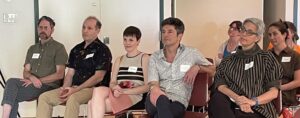
Image (left to right): jg mair, Jeremy Heyl, Alannah Hallas, Andrea Damascelli, Sarah Burke (behind), Shelly Rosenblum, Kim Kiloh.
“Artists and scientists often exist in their own disciplinary silos. Ars Scientia has set out to rewrite this narrative by engaging our participating artists and scientists to join the art studio, the humanities seminar room, and the science lab,” Rosenblum said.
“Rather than science simply engaging artistic practice for the sake of science, or vice versa, the purpose of our project is to offer an alternate reality where art and science meet as equal partners on a journey into the unknown.”
Blusson QMI Scientific Director and Ars Scientia Principal Investigator Andrea Damascelli commended the work of the participating artists and scientists, noting Ars Scientia is a unique program that actively challenges stereotypes.
“This year’s symposium is titled encou(n)ters, which I find especially inspiring as the works on view today are the results of many encounters between our resident artists and physicists,” said Damascelli. “I’m pleased to see the program has grown to have seven resident artists producing meaningful works that blend the two worlds.”
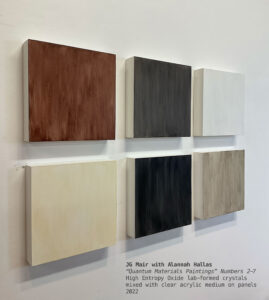
As part of the event, Blusson QMI Principal Investigator Alannah Hallas and media/visual artist jeff mair provided a showcase of their project Quantum Materials Paintings, which were produced with a paint made of lab-formed crystals mixed with clear acrylic medium on panels.
“During our first walk through my lab, I showed jeff [jg mair] and Timothy the literal skeletons in my closet, the hundreds of sample vials containing the results of our synthesis attempts some of which had succeeded, but the majority of which had not,” said Hallas who leads Blusson QMI’s Materials Design Lab.
“To my great surprise, while most visitors are captivated by our crystal samples that have an appearance that resembles natural gemstones, jeff was particularly interested in some of our powder samples, which look like flour or fine sand. Off the cuff, he asked me a provocative question: ‘I want to turn the samples into paint if that’s okay with you?’”
At first, Hallas said no. She worried about safety concerns and thought it was improper to permanently remove samples from the lab, even if they were unsuccessful synthesis attempts.
“But over the next couple of weeks, the idea sat in my brain and continued to nag at me. I thought about the historic connection between pigments and chemistry. And in fact, historically, the distinction between a chemist and an artist was really nonexistent, and one of the most important goals of chemistry was to produce new pigments.
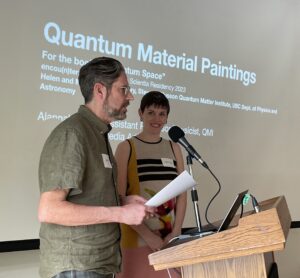
Image (left to right): jg mair, visual/media artist and Alannah Hallas, Principal Investigator at Blusson QMI.
“When I sat with that thought, it began to seem bizarre to me that these two fields have diverged to such an extent that I would find it blasphemous even to consider turning one of our materials into a pigment.
“I began to feel a genuine excitement at the prospect of one of our materials finding a second life on an artist’s paintbrush.”
Hallas and mair reconvened at Blusson QMI for a trial run where they mixed a quantum material with clear acrylic paint, which mair took to his studio to produce the first painting in the series.
“For choosing the colors, I completely removed myself from the equation and asked if Alannah was comfortable making those calls. Since these materials are her life’s work, I was curious to see what criteria informed her choices,” said mair.
“This relinquishing of control for me as an artist put me squarely outside of my comfort zone, but it was also oddly liberating.”
The Symposium was concluded with a keynote lecture by the President’s Excellence Chair in Network Cultures and Professor in UBC’s Department of English Language and Literatures, Kavita Philip.
A recording of the Symposium will be made available here soon.
*jg (jeff) mair wishes for his name to be written free from capital letters.
